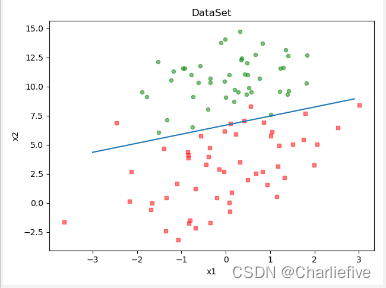-
Python3《机器学习实战》学习笔记(五):Logistic回归基础篇之梯度上升算法
一、简介
通过Logistic回归和梯度上升两方法开始,首先从原理开始推论。
二、Logistic回归
链接: 可以参照之前写过的文章(吴恩达机器学习课里面的)
因为里面公式推导都是类似的,因此可以直接拿来用这个例子主要是主要用来模拟迭代的方式。就像爬坡一样,一点点的逼近极值
''' 主要用来模拟迭代的方式。就像爬坡一样,一点点的逼近极值 函数说明:梯度上升算法测试函数 求函数f(x) = -x^2 + 4x的极大值 @Project :MachineLearning @File :Gradient.py @Author :Kyrie Irving @Date :2022/10/27 16:29 ''' def Gradient_Ascent_test(): # 这个给出的是原函数f(x)求导的结果 def f_prime(x_old): return -2 * x_old + 4 x_old = -1 x_new = 0 alpha = 0.01 presision = 0.00000001 #精度,也就是更新阈值 while abs(x_old - x_new) > presision: x_old = x_new x_new = x_old + alpha * f_prime(x_old) print(x_new) if __name__ == '__main__': Gradient_Ascent_test() 1.999999515279857 Process finished with exit code 0- 1
- 2
- 3
- 4
- 5
- 6
- 7
- 8
- 9
- 10
- 11
- 12
- 13
- 14
- 15
- 16
- 17
- 18
- 19
- 20
- 21
- 22
- 23
- 24
- 25
- 26
- 27
- 28
- 29
- 30
- 31
- 32
- 33
- 34
- 35
剩下的公式推导

到这里公式推导完毕!三、代码实战
3.1 加载数据
''' 函数说明:加载数据 ''' def loadDataSet(): dataMat = [] # 创建数据列表 labelMat = [] # 创建标签列表 fr = open('testSet.txt') for line in fr.readlines(): lineArr = line.strip().split() dataMat.append([1.0, float(lineArr[0]), float(lineArr[1])]) labelMat.append(float(lineArr[2])) fr.close() return dataMat, labelMat- 1
- 2
- 3
- 4
- 5
- 6
- 7
- 8
- 9
- 10
- 11
- 12
- 13
- 14
3.2 函数
def sigmoid(inX): return 1.0 / (1 + np.exp(-inX))- 1
- 2
3.3梯度上升算法
''' 函数说明:梯度上升算法 ''' def gradAscent(dataMatIn, classLabels): dataMatrix = np.mat(dataMatIn) labelMat = np.mat(classLabels).transpose() m, n = np.shape(dataMatrix) # 返回dataMatrix的大小。m为行数,n为列数。 alpha = 0.001 #移动步长,也就是学习速率,控制更新的幅度。 maxCycles = 500 # 最大迭代次数 # 这里的weights 可以理解成theta 一直在变化 weights = np.ones((n, 1)) print(weights) for k in range(maxCycles): h = sigmoid(dataMatrix * weights) # labelMat相当于y y不一定是纵坐标 这里是两种类型分类的目的 error = labelMat - h weights = weights + alpha * dataMatrix.transpose() * error print('weights', weights) return weights.getA()- 1
- 2
- 3
- 4
- 5
- 6
- 7
- 8
- 9
- 10
- 11
- 12
- 13
- 14
- 15
- 16
- 17
- 18
- 19
- 20
- 21
3.4绘制数据集
''' 函数说明:绘制数据集 ''' def plotDataSet(weights): dataMat, labelMat = loadDataSet() dataArr = np.array(dataMat) # 转换成numpy的array数组 m = np.shape(dataMat)[0] # 数据个数 xcord1 = [] ycord1 = [] # 正样本 xcord2 = [] ycord2 = [] # 负样本 for i in range(m): if int(labelMat[i]) == 1: xcord1.append(dataArr[i, 1]) ycord1.append(dataArr[i, 2]) else: xcord2.append(dataArr[i, 1]) ycord2.append(dataArr[i, 2]) # 画图 print(xcord1, ycord1, xcord2, ycord2) fig = plt.figure() ax = fig.add_subplot(111) # 添加subplot 该图所在位置 第一行第一列第一个 ax.scatter(xcord1, ycord1, s=20, c='red', marker='s', alpha=.5) # 绘制正样本 ax.scatter(xcord2, ycord2, s=20, c='green', alpha=.5) # 绘制负样本 # 画线 x = np.arange(-3.0, 3.0, 0.1) y = (-weights[0] - weights[1] * x) / weights[2] # 这部分可以公式推导 假设weights = [a0, a1, a2] 那么a0 + a1*x + a2*y = 0 ax.plot(x, y) plt.title('DataSet') # 绘制title plt.xlabel('x1') plt.ylabel('x2') # 绘制label plt.show() # 显示- 1
- 2
- 3
- 4
- 5
- 6
- 7
- 8
- 9
- 10
- 11
- 12
- 13
- 14
- 15
- 16
- 17
- 18
- 19
- 20
- 21
- 22
- 23
- 24
- 25
- 26
- 27
- 28
- 29
- 30
- 31
- 32
- 33
- 34
- 35
- 36
3.5主函数
if __name__ == '__main__': dataMat, labelMat = loadDataSet() weights = gradAscent(dataMat, labelMat) plotDataSet(weights)- 1
- 2
- 3
- 4
- 5

四、总结
收集数据:采用任意方法收集数据。
准备数据:由于需要进行距离计算,因此要求数据类型为数值型。另外,结构化数据格式则最佳。
分析数据:采用任意方法对数据进行分析。
训练算法:大部分时间将用于训练,训练的目的是为了找到最佳的分类回归系数。
测试算法:一旦训练步骤完成,分类将会很快。
使用算法:首先,我们需要输入一些数据,并将其转换成对应的结构化数值;接着,基于训练好的回归系数,就可以对这些数值进行简单的回归计算,判定它们属于哪个类别;在这之后,我们就可以在输出的类别上做一些其他分析工作。
其他:Logistic回归的目的是寻找一个
非线性函数Sigmoid的最佳拟合参数,求解过程可以由最优化算法完成。
本文讲述了Logistic回归原理以及数学推导过程。 -
相关阅读:
Java 多线程编程
基于SSM框架茶叶商城系统【项目源码+数据库脚本+报告】
力扣3.无重复字符的最长子串(JavaScript版本)
【11.2】【VP】Codeforces Round #728 (Div. 2)
Linux 线程互斥
创建你的第一个Vue项目(小白专享版本)
推荐一个专利检索的网站
【前端】伪元素的postion:absolute是对哪里的?
同一个接口时快时慢。一次慢的,三四次是快的。怎么回事?
在nvidia-docker容器中测试TensorFlow-Slim 训练图像分类模型
- 原文地址:https://blog.csdn.net/weixin_43886282/article/details/127555081